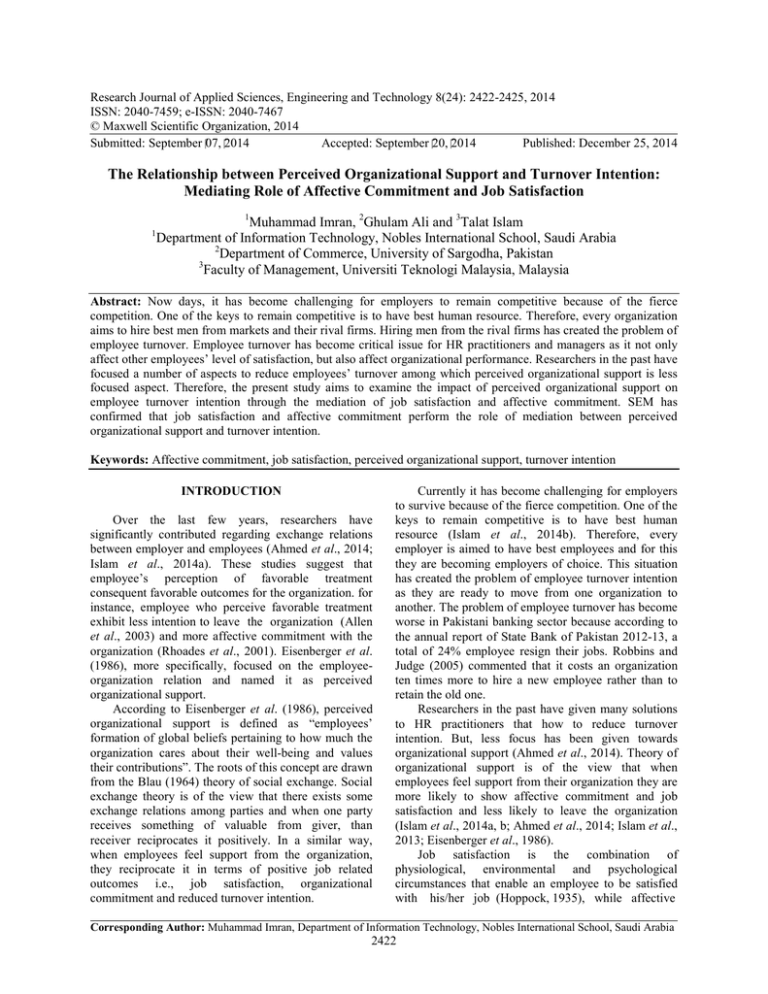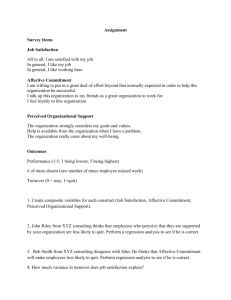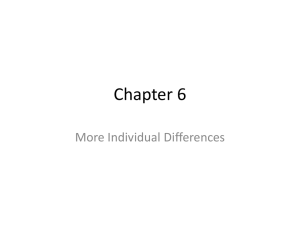Research Journal of Applied Sciences, Engineering and Technology 8(24): 2422-2425,... ISSN: 2040-7459; e-ISSN: 2040-7467
advertisement

Research Journal of Applied Sciences, Engineering and Technology 8(24): 2422-2425, 2014 ISSN: 2040-7459; e-ISSN: 2040-7467 © Maxwell Scientific Organization, 2014 Submitted: September 07, 2014 Accepted: September 20, 2014 Published: December 25, 2014 The Relationship between Perceived Organizational Support and Turnover Intention: Mediating Role of Affective Commitment and Job Satisfaction 1 Muhammad Imran, 2Ghulam Ali and 3Talat Islam 1 Department of Information Technology, Nobles International School, Saudi Arabia 2 Department of Commerce, University of Sargodha, Pakistan 3 Faculty of Management, Universiti Teknologi Malaysia, Malaysia Abstract: Now days, it has become challenging for employers to remain competitive because of the fierce competition. One of the keys to remain competitive is to have best human resource. Therefore, every organization aims to hire best men from markets and their rival firms. Hiring men from the rival firms has created the problem of employee turnover. Employee turnover has become critical issue for HR practitioners and managers as it not only affect other employees’ level of satisfaction, but also affect organizational performance. Researchers in the past have focused a number of aspects to reduce employees’ turnover among which perceived organizational support is less focused aspect. Therefore, the present study aims to examine the impact of perceived organizational support on employee turnover intention through the mediation of job satisfaction and affective commitment. SEM has confirmed that job satisfaction and affective commitment perform the role of mediation between perceived organizational support and turnover intention. Keywords: Affective commitment, job satisfaction, perceived organizational support, turnover intention INTRODUCTION Over the last few years, researchers have significantly contributed regarding exchange relations between employer and employees (Ahmed et al., 2014; Islam et al., 2014a). These studies suggest that employee’s perception of favorable treatment consequent favorable outcomes for the organization. for instance, employee who perceive favorable treatment exhibit less intention to leave the organization (Allen et al., 2003) and more affective commitment with the organization (Rhoades et al., 2001). Eisenberger et al. (1986), more specifically, focused on the employeeorganization relation and named it as perceived organizational support. According to Eisenberger et al. (1986), perceived organizational support is defined as “employees’ formation of global beliefs pertaining to how much the organization cares about their well-being and values their contributions”. The roots of this concept are drawn from the Blau (1964) theory of social exchange. Social exchange theory is of the view that there exists some exchange relations among parties and when one party receives something of valuable from giver, than receiver reciprocates it positively. In a similar way, when employees feel support from the organization, they reciprocate it in terms of positive job related outcomes i.e., job satisfaction, organizational commitment and reduced turnover intention. Currently it has become challenging for employers to survive because of the fierce competition. One of the keys to remain competitive is to have best human resource (Islam et al., 2014b). Therefore, every employer is aimed to have best employees and for this they are becoming employers of choice. This situation has created the problem of employee turnover intention as they are ready to move from one organization to another. The problem of employee turnover has become worse in Pakistani banking sector because according to the annual report of State Bank of Pakistan 2012-13, a total of 24% employee resign their jobs. Robbins and Judge (2005) commented that it costs an organization ten times more to hire a new employee rather than to retain the old one. Researchers in the past have given many solutions to HR practitioners that how to reduce turnover intention. But, less focus has been given towards organizational support (Ahmed et al., 2014). Theory of organizational support is of the view that when employees feel support from their organization they are more likely to show affective commitment and job satisfaction and less likely to leave the organization (Islam et al., 2014a, b; Ahmed et al., 2014; Islam et al., 2013; Eisenberger et al., 1986). Job satisfaction is the combination of physiological, environmental and psychological circumstances that enable an employee to be satisfied with his/her job (Hoppock, 1935), while affective Corresponding Author: Muhammad Imran, Department of Information Technology, Nobles International School, Saudi Arabia 2422 Res. J. Appl. Sci. Eng. Technol., 8(24): 2422-2425, 2014 and noted its reliability as 0.67 and turnover intention was measured using three items scale of Lichtenstein et al. (2004) with the reliability of 0.81. JS TI POS RESULTS AND DISCUSSION AC The values of Mean and Standard Deviation for all the variables used in the present study are shown in Table 1. The values identify that most of the respondents were near to agree regarding their Perception of Organizational Support (POS), Job Satisfaction (JS) and Affective Commitment (AC). While, the mean value of Turnover Intention (TI) identify that respondents were near to neutral regarding turnover intention. In addition to this, all the variables were found to be significantly correlated with each other, but a high correlation was found between job satisfaction and affective commitment (r = 0.609). This identifies that satisfied employees exhibit more affective commitment with their organization. On the other side, POS, JS and AC were found to reduce employees intention to leave the organization (i.e., r = -0.469, -0.561 and -0.477, respectively). Following the instructions of Diamantopoulos and Siguaw (2000), SEM assessment analysis was determined to support the theoretical relationships specified at the conceptualization phase. Path coefficient was used to determine the hypothesis. The hypothesized model indicated a good fit in all indices (X2 = 1057.277; p<0.00; x2/df = 2.098; RMSEA = 0.038; NFI = 0.871; CFI = 0.927; GFI = 0.923; AGFI = 0.909; IFI = 0.928) (Fig. 2). Path coefficient identifies a non-significant association between POS and TI (β = 0.102, p = 0.121). Similarly, JS and AC were also examined as a mediator between POS and TI. The study noted a significant Fig. 1: Hypothesized model commitment is the employee’s emotional attachment with the organization (Allen and Meyer, 1990). Researchers are of the view that both job satisfaction and affective commitment are essential in reducing employees’ intention to leave the organization (Islam et al., 2013; Kim and Chang, 2012). Furthermore, Job satisfaction and affective commitment have been found to perform the role of mediation between variables by earlier researchers (Kim and Chang, 2012; Yi and Lee, 2012; Islam et al., 2013; Ahmed et al., 2014). Therefore, this study is aimed to examine the role of POS in reducing banking employees’ intention to leave the organization through mediation of job satisfaction and affective commitment as so much investigation has not been conducted in this regard (Fig. 1). METHODOLOGY A questionnaire based survey was employed using 758 employees working in Pakistani banking sector on the basis of convenience sampling method from six major cities. Respondents were also asked for some demographical statistics i.e., 64.4% of the respondents were male, 29.6% of them were between the ages of 3545 years, 38.7% of them were holding masters’ degree and 40.8% of them were with the same organization for 2-5 years. Respondents responses were collected on the basis of five points Likert scale ranging from 1 = strongly disagree to 5 = strongly agree. To measure POS, a 6 items scale was used (Eisenberger et al., 1986) and noted its reliability as 0.76. Job satisfaction was measured using (Cammann et al., 1983) three items scale with the reliability of 0.85. Affective commitment was measured through 6 items scale (with the best factor loading) developed by Meyer and Allen (1997) Table 1: Descriptive statistics and correlation Variables Mean S.D. 1 2 1.POS 3.69 0.629 2.JS 3.89 0.812 0.535** 3.AC 3.68 0.671 0.530** 0.609** 4.TI 2.72 0.982 -0.469** -0.561** **: p<0.01; *: p<0.05; S.D.: Standard deviation JS -0.278* 0.345** POS TI 0.102 0.245** AC Fig. 2: Structural model using SEM 2423 -0.401* 3 -0.477** Res. J. Appl. Sci. Eng. Technol., 8(24): 2422-2425, 2014 indirect path between POS and TI through JS (Direct path = non-significant, Indirect path = -0.096*) which confirms the mediation role of JS between POS and TI. Similarly, AC was also found to perform the role of mediation between POS and TI (Direct path = nonsignificant, Indirect path = -0.098*). The present study was aimed to examine the direct and indirect role of POS in reducing employee intention to leave the organization. Using path coefficient, POS was found to influence JS and AC positively and significantly (β = 0.345, 0.245, respectively), but a nonsignificant relation between POS and TI was identified (β = 0.102, p = 0.121). This finding is in accordance with the finding of Karatepe and Karadas (2012) who commented that POS might influence on TI through mediation. While, JS and AC were found to perform the role of full mediation between POS and TI. These findings are in accordance with the earlier researchers (Kim and Chang, 2012; Yi and Lee, 2012; Islam et al., 2013; Ahmed et al., 2014) who found JS and AC performing the role of mediator. Theory of organizational support also suggests that when employees feel support from their organization they reciprocate it through positive job related outcomes i.e., job satisfaction and commitment, which ultimately reduce their intention to leave the organization (Ahmed et al., 2014; Islam et al., 2013; Eisenberger et al., 1986). Thus, HR practitioners should realize that the organization takes care of its employees as organizational support creates an obligation among employees not to leave the organization. CONCLUSION The present study was aimed to examine the relationship between perceived organizational support, turnover intention, job satisfaction and affective commitment among the Pakistani banking employees. SEM was applied to support the suggested hypotheses. Results of the study revealed that POS indirectly helps satisfied and emotionally attached employees to retain with the organization. RECOMMENDATIONS AND LIMITATIONS The current study was having few limitations. Firstly, the data was collected at one point of time. Secondly, the number of male respondents was more as compared to female which might raise a question on gender discrimination. Therefore, the future researchers should conduct longitudinal study for better understanding regarding POS and employees attitudes. The present study uses AC as mediation between POS and TI, Normative Commitment (NC) and Continuance Commitment (CC) should also be focused as they are equally important from organizational perspective. REFERENCES Ahmed, I., W.K.W. Ismail, S.M. Amin and T. Islam, 2014. Role of perceived organizational support in faculty’s responsiveness and students outcomes. Int. J. Educ. Manage., 28(2): 246-256. Allen, N.J. and J.P. Meyer, 1990. The measurement and antecedents of affective, continuance and normative commitment to the organization. J. Occup. Psychol., 63: 1-18. Allen, D.G., L.M. Shore and R.W. Griffeth, 2003. The role of perceived organizational support and supportive human resource practices in the turnover process. J. Manage., 29: 99-118. Blau, P.M., 1964. Exchange and Power in Social Life. Wiley, New York. Cammann, C., M. Fichman, G.D. Jenkins Jr. and J.R. Klesh, 1983. Assessing the Attitudes and Perceptions of Organizational Members. In: Seashore, S.E., E.E. Lawler, P.H. Mirvis and C. Cammann (Eds.), Assessing Organizational Change. John Wiley and Sons, New York. Diamantopoulos, A. and J.A. Siguaw, 2000. Introducing LISREL. Sage Publications, London. Eisenberger, R., R. Huntington, S. Hutchison and D. Sowa, 1986. Perceived organizational support. J. Appl. Psychol., 71: 500-507. Hoppock, R., 1935. Job Satisfaction. Harper and Brothers, New York. Islam, T., S.U.R. Khan, U.N.U. Ahmad and I. Ahmed, 2014a. Exploring the relationship between POS, OLC, Job satisfaction and OCB. Proc. Soc. Behav. Sci., 114: 164-169. Islam, T., S.U.R. Khan, U.N.U. Ahmad, G. Ali and I. Ahmed, 2014b. Consequences of psychological empowerment and organizational learning culture: A mediation model. Asia-Pac. J. Bus. Admin., 7(1). Islam, T., S.U.R. Khan, U.N.U. Ahmad, G. Ali, I. Ahmed and Z.A. Bowra, 2013. Turnover intentions: The role of perceived organizational support and organizational commitment. Proc. Soc. Behav. Sci., 103: 1237-1241. Karatepe, O.M. and G. Karadas, 2012. The effect of management commitment to service quality on job embeddedness and performance outcomes. J. Bus. Econ. Manag., 13(4): 614-636. Kim, T. and K. Chang, 2012. Turnover intentions and organizational citizenship behavior in Korean firms: The interactional effect of organizational and occupational commitment. Asia Pac. Bus. Rev., 20(1): 59-77. Lichtenstein, R., J.A. Alexander, J.F. McCarthy and R. Wells, 2004. Status differences in cross functional teams: Effect on individual member participation, job satisfaction and intent to quit. J. Health Soc. Behav., 45: 322-335. 2424 Res. J. Appl. Sci. Eng. Technol., 8(24): 2422-2425, 2014 Meyer, J.P. and N.J. Allen, 1997. Commitment in the Workplace: Theory, Research and Application. Sage, Thousand Oaks, CA. Rhoades, L., R. Eisenberger and S. Armeli, 2001. Affective commitment to the organization: The contribution of perceived organizational support. J. Appl. Psychol., 86: 825-836. Robbins, S. and T. Judge, 2005. Organizational Behavior. 14th Edn., Prentice Hall. Yi, H.Y. and M.K. Lee, 2012. The mediating role of job satisfaction and commitment in the relationship between each of job characteristics and turnover intentions of shopping center employees. J. Global Acad. Market. Sci., 10(1): 27-43. 2425




